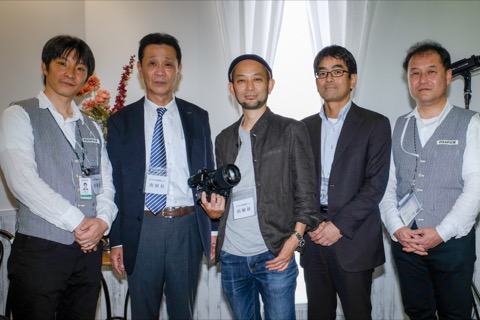
DC.Watch has an interesting interview with Mr. Yasunori Hirai of Professional Photo Sales Division Manager of Photo Imaging Division FUJIFILM Imaging Systems Co., Ltd. and Mr. Koshiuchi Koshiuchi of Pros Marketing Team Manager, Sales Support Department, Digital Camera Division. Below are some excerpts:
- GFX JPEG’s were designed to be final images ready to print from the start.
“Nowadays, with digital cameras, it is mainstream to adjust RAW data after shooting, but this is a completely different flow from film, so even veteran people who could not keep up with this change once and who have been shaken off from professional work It was pretty.In the GFX 50S, the image is completed at the time of pressing the shutter, which is close to the feeling of filming, and because it means that almost no digital post-processing is required, I think that it is easy to handle even for people.” - Fujifilm is well aware of their color advantage.
“That’s color making. As we are doing films and printing all the time as a business, there is accumulation of know-how on what kind of color should be finally made. For example, the impression of the color seen by a person, the so-called “memory color” and the actual color are different.Regarding how to fill that gap, there is a past that has cut off from competing film makers, and I think that it is our strength to know that “I know the ultimate goal” that I have studied at that time.” - EVF is ideal for professionals because you see what you are getting and now they can keep up.
“Even when digital cameras became mainstream as well as the age of film cameras, this was a problem that could not be realized easily due to the performance problem of EVF. In recent years, however, we decided to mirrorless even in medium format, based on the advent of a high-performance image processing engine and EVF, which enabled us to be practical enough.” - Fujifilm is aggressively expanding the GFX lineup which is apparent from our extremely reliable sources. You can also see the GFX performance improvements in the new lens lineup, which is faster than the launch lineup. I have no doubt Fujifilm will continue to greatly expand performance going forward, which is typical Fujifilm and it’s good to hear they want to continue working with software venders to improve support.
“Kiuchi: I want to urgently expand the lens lineup. Since there are still many focal lengths that can not be covered for the required applications, I’d like to first use a resource for developing a telephoto lens and developing a teleconverter.
HIRAI: Regarding the body, I want to correspond as much as possible to the part that can be solved with firmware, including the speed of AF and shooting function. Regarding shooting data, I also want to improve cooperation with software other than genuine.”
You can read the full interview at DC.Watch and stay tuned to FujiAddict for everything GFX.
Join our Fujifilm GFX Owners Group which is growing rapidly, also follow the Fujifilm GFX Page to get more tailored news on Facebook and follow Fujiaddict on Facebook and Twitter.
Fujifilm GFX 50S: B&H Photo / Amazon / Adorama
Fujinon GF 110mm F 2 R LM WR: B&H Photo / Amazon / Adorama
Fujinon GF 23mm F 4 R LM WR: B&H Photo / Amazon / Adorama
Fujinon GF 63mm F2.8 R WR: B&H Photo / Amazon / Adorama
Fujinon GF 120 f4 R LM OIS WR Macro: B&H Photo / Amazon / Adorama
Fujinon GF 32-64mm f4 R LM WR: B&H Photo / Amazon / Adorama
